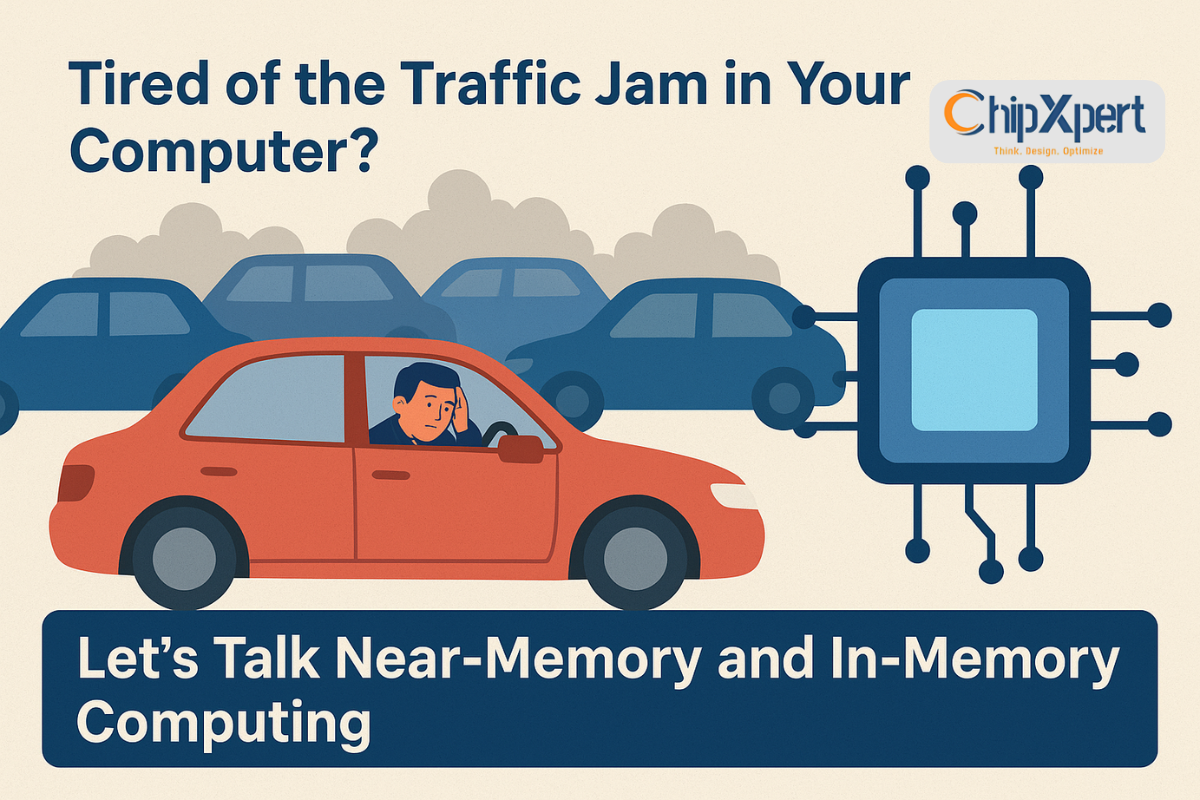Tired of the Traffic Jam in Your Computer? Let’s Talk Near-Memory and In-Memory Computing
Think about the last time you felt your computer slow to a crawl. Maybe you were rendering a video, training a machine learning model, or just trying to open too many browser tabs at once. That frustrating lag, more often than not, stems from a fundamental bottleneck that’s been in our machines for over half a century: the von Neumann architecture.
This classic design, where the Central Processing Unit (CPU) and memory are separate, forces a constant, tedious back-and-forth over a narrow data highway (the bus). It’s like having a brilliant chef (the CPU) in a giant kitchen who has to run to a separate, massive pantry (the memory) for every single ingredient. Even the fastest chef spends most of their time running, not cooking.
But what if we could bring the ingredients to the chef? Or better yet, what if the pantry itself could do the cooking?
Welcome to the world of near-memory and in-memory computing—architectures that are shattering the von Neumann bottleneck and paving the way for a new era of efficiency.
The Problem: The Von Neumann Bottleneck
In traditional computing, every single operation—every calculation, every decision—requires a trip across the bus. This process, often called the “fetch-decode-execute” cycle, creates a massive traffic jam. The CPU, which can perform billions of operations per second, is often left idling, waiting for data to arrive. This is the von Neumann bottleneck.
As we generate exponentially more data, especially in fields like AI and big data analytics, this bottleneck isn’t just an inconvenience; it’s a wall we’re about to hit. The energy cost of moving data is now vastly higher than the cost of actually computing it.
The Solutions: Moving Computation to the Data
To break through, engineers are rethinking the very layout of the silicon. Instead of moving data to the compute, they’re moving compute to the data. This happens in two key ways:
1. Near-Memory Computing: Putting the Kitchen Next to the Pantry
Near-memory computing doesn’t eliminate the separation between CPU and memory, but it drastically shortens the distance. The most common example is High-Bandwidth Memory (HBM).
Imagine our chef now has a small, prep kitchen right inside the massive pantry. All the essential ingredients are an arm’s length away. In technical terms, HBM stacks memory dies vertically and connects them to the CPU or GPU using a super-wide, ultra-fast interconnect called a silicon interposer. This “3D stacking” provides a huge boost in bandwidth, allowing data to flow much faster. It’s a powerful upgrade that’s already inside many high-performance GPUs and AI accelerators, drastically speeding up data-intensive tasks.
For a deeper dive into how advanced packaging technologies like this are revolutionizing chip design, you can explore our guide on Understanding Semiconductor Packaging.
2. In-Memory Computing: Turning the Pantry into a Kitchen
This is where things get truly revolutionary. In-memory computing aims to perform computations directly within the memory array itself, using the physical properties of the memory cells.
Sticking with our analogy: what if each shelf in the pantry could chop, mix, and sauté its own ingredients? There’s no fetching or moving; the work happens right where the data lives.
This is often achieved using Memristors or other non-volatile memory technologies. By applying specific voltages, you can use a crossbar array of memory cells to perform operations like matrix multiplication—the core math behind neural networks—in a single step. This isn’t just faster; it’s a fundamentally different and more efficient way of computing, potentially reducing energy consumption by orders of magnitude.
Which One is Practical Today?
- Near-Memory (HBM) is here now. It’s a commercially mature technology used in everything from top-tier data center GPUs to high-end FPGAs. It’s a practical solution for today’s most demanding computing workloads.
- In-Memory Computing is the exciting frontier. While promising monumental gains, it’s primarily in the research and development phase, with prototypes being tested in labs. Challenges remain in manufacturing, reliability, and programming models. But its potential for AI is staggering.
The Human Impact: Why Should You Care?
This isn’t just academic. This shift means:
- Smarter AI, Instantly: Real-time language translation, medical diagnosis from complex imaging, and smarter personal assistants that don’t need a cloud connection.
- Massive Energy Savings: Doing more with less power is crucial for our environment and for extending the battery life of your devices.
- Unlocking New Possibilities: It enables applications we haven’t even dreamed of yet, from complex real-time simulations to immersive AR/VR worlds, all by finally unleashing the true potential of our silicon.
The journey beyond von Neumann isn’t about a single invention; it’s a fundamental re-imagining of the relationship between memory and logic. It’s about building computers that work a little more like our own efficient brains, and a little less like a chef stuck in traffic.To learn more about the latest research in memory technologies, a great external resource is the IEEE Spectrum article on Processing-in-Memory.



